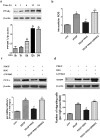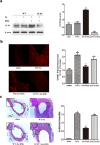PPARγ Inhibits VSMC Proliferation and Migration via Attenuating Oxidative Stress through Upregulating UCP2
- PMID: 27144886
- PMCID: PMC4856345
- DOI: 10.1371/journal.pone.0154720
PPARγ Inhibits VSMC Proliferation and Migration via Attenuating Oxidative Stress through Upregulating UCP2
Abstract
Increasing evidence showed that abnormal proliferation and migration of vascular smooth muscle cells (VSMCs) are common event in the pathophysiology of many vascular diseases, including atherosclerosis and restenosis after angioplasty. Among the underlying mechanisms, oxidative stress is one of the principal contributors to the proliferation and migration of VSMCs. Oxidative stress occurs as a result of persistent production of reactive oxygen species (ROS). Recently, the protective effects of peroxisome proliferator-activated receptor γ (PPARγ) against oxidative stress/ROS in other cell types provide new insights to inhibit the suggests that PPARγ may regulate VSMCs function. However, it remains unclear whether activation of PPARγ can attenuate oxidative stress and further inhibit VSMC proliferation and migration. In this study, we therefore investigated the effect of PPARγ on inhibiting VSMC oxidative stress and the capability of proliferation and migration, and the potential role of mitochondrial uncoupling protein 2 (UCP2) in oxidative stress. It was found that platelet derived growth factor-BB (PDGF-BB) induced VSMC proliferation and migration as well as ROS production; PPARγ inhibited PDGF-BB-induced VSMC proliferation, migration and oxidative stress; PPARγ activation upregulated UCP2 expression in VSMCs; PPARγ inhibited PDGF-BB-induced ROS in VSMCs by upregulating UCP2 expression; PPARγ ameliorated injury-induced oxidative stress and intimal hyperplasia (IH) in UCP2-dependent manner. In conclusion, our study provides evidence that activation of PPARγ can attenuate ROS and VSMC proliferation and migration by upregulating UCP2 expression, and thus inhibit IH following carotid injury. These findings suggest PPARγ may represent a prospective target for the prevention and treatment of IH-associated vascular diseases.
Conflict of interest statement
Figures





Similar articles
-
PPARγ attenuates intimal hyperplasia by inhibiting TLR4-mediated inflammation in vascular smooth muscle cells.Cardiovasc Res. 2011 Dec 1;92(3):484-93. doi: 10.1093/cvr/cvr238. Epub 2011 Aug 31. Cardiovasc Res. 2011. PMID: 21880694
-
Nesfatin-1 promotes VSMC migration and neointimal hyperplasia by upregulating matrix metalloproteinases and downregulating PPARγ.Biomed Pharmacother. 2018 Jun;102:711-717. doi: 10.1016/j.biopha.2018.03.120. Epub 2018 Apr 5. Biomed Pharmacother. 2018. PMID: 29604590
-
DDX17 deficiency inhibits the proliferation and migration of vascular smooth muscle cells by inhibiting RHEB/mTORC1-mediated glycolysis and oxidative stress.J Hypertens. 2025 Jul 1;43(7):1232-1246. doi: 10.1097/HJH.0000000000004043. Epub 2025 May 2. J Hypertens. 2025. PMID: 40439185
-
Reactive Oxygen Species: Modulators of Phenotypic Switch of Vascular Smooth Muscle Cells.Int J Mol Sci. 2020 Nov 20;21(22):8764. doi: 10.3390/ijms21228764. Int J Mol Sci. 2020. PMID: 33233489 Free PMC article. Review.
-
Oxidative stress and vascular smooth muscle cell growth: a mechanistic linkage by cyclophilin A.Antioxid Redox Signal. 2010 Mar 1;12(5):675-82. doi: 10.1089/ars.2009.2875. Antioxid Redox Signal. 2010. PMID: 19747062 Free PMC article. Review.
Cited by
-
Vascular hyperacetylation is associated with vascular smooth muscle dysfunction in a rat model of non-obese type 2 diabetes.Mol Med. 2022 Mar 8;28(1):30. doi: 10.1186/s10020-022-00441-4. Mol Med. 2022. PMID: 35260080 Free PMC article.
-
Exercise training mitigates ER stress and UCP2 deficiency-associated coronary vascular dysfunction in atherosclerosis.Sci Rep. 2021 Jul 29;11(1):15449. doi: 10.1038/s41598-021-94944-5. Sci Rep. 2021. PMID: 34326395 Free PMC article.
-
Vascular Dysfunction in Diabetes and Obesity: Focus on TRP Channels.Front Physiol. 2021 Feb 26;12:645109. doi: 10.3389/fphys.2021.645109. eCollection 2021. Front Physiol. 2021. PMID: 33716794 Free PMC article. Review.
-
Yohimbine, an α2-Adrenoceptor Antagonist, Suppresses PDGF-BB-Stimulated Vascular Smooth Muscle Cell Proliferation by Downregulating the PLCγ1 Signaling Pathway.Int J Mol Sci. 2022 Jul 21;23(14):8049. doi: 10.3390/ijms23148049. Int J Mol Sci. 2022. PMID: 35887391 Free PMC article.
-
Jujuboside B Inhibits Neointimal Hyperplasia and Prevents Vascular Smooth Muscle Cell Dedifferentiation, Proliferation, and Migration via Activation of AMPK/PPAR-γ Signaling.Front Pharmacol. 2021 Jun 24;12:672150. doi: 10.3389/fphar.2021.672150. eCollection 2021. Front Pharmacol. 2021. PMID: 34248626 Free PMC article.
References
Publication types
MeSH terms
Substances
LinkOut - more resources
Full Text Sources
Other Literature Sources
Molecular Biology Databases

